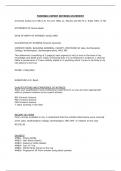FORENSIC EXPERT WITNESS STATEMENT
(Criminal Justice Act 1967,s.9; M.C.Act 1980, ss. 5A(3A) and 5B; M.C. Rules 1981. R.70)
STATEMENT OF Aimee Baish
DATE OF BIRTH OF WITNESS 10/02/1990
OCCUPATION OF WITNESS Forensic Scientist
COMPANY NAME, BUILDING ADDRESS, COUNTY, POSTCODE NC labs, Northampton
College, Northampton, Northamptonshire, NN3 3RF.
This statement (consisting of 5 page(s) each signed by me) is true to the best of my
knowledge and belief and I make it knowing that, if it is tendered in evidence, I shall be
liable to prosecution if I have wilfully stated in it anything which I know to be false or do
not believe to be true.
DATED 17/06/2022
SIGNATURE A.M. Baish
QUALIFICATIONS AND EXPERIENCE OF WITNESS
State your qualifications and professional experience to so you are have appropriate
skills to present evidence as an expert witness.
BSc Forensic Science
MSc Forensic Science
PhD Forensic Science
7 years working in the field
RECIEPT OF ITEMS
From records available to me, I understand that the exhibits listed below were received
at NC Labs, Northampton College, Northampton, NN3 3RF. In relation to the case
NC/52136.
EXHIBITS
AMB/1- Poison Bottle
AMB/2- Hair fibres (black)
AMB/3- Packet of white tablets
AMB/4- Can of 7-Up
AMB/5- White fibres found on the rug
AMB/6- Fingerprint lift from window using black powder
, PURPOSE OF THE EXAMINATION
On exhibit AMB/1, thin layer chromatography was carried out. Thin layer
chromatography is used to determine which substances are in a mixture by calculating
their Rf values. Thin layer chromatography was carried out on the unknown liquid in the
poison bottle, through the analysis of the Rf values in our results, we can find which
substances are present in the liquid. This would also be able to tell us whether the
mixture is harmful to humans.
For exhibit AMB/2, hair microscopy was carried out, this was where a hair sample was
looked at under a microscope and then sent for DNA analysis to determine who the hair
belonged to. This was used to determine hair type and colour to narrow down who it
came from.
On exhibit AMB/3, mass spectrometry was carried out, this was used to identify the
amount and types of the substances present in the white tablets, this would then tell us
which type(s) of tablets these were. It would also tell us if these tablets were harmful.
For exhibit AMB/4, an empty can of 7-Up had cyanoacrylate fuming performed on it, this
revealed any latent fingerprints which were left on the can. After these latent prints were
lifted and have been photographed, they were then inspected through a Loup, this
helped to compare it with another print from the scene and then determine if these
prints matched, and whether the print on the can was from the perpetrator.
On exhibit AMB/5, fibre microscopy was carried out, this where the fibres were both
looked at under a microscope, this meant that the type of the fibre would be identified
from what it looked like, each fibre was then compared to each other so that we could
determine whether they matched or not, and whether the perpetrator had left it there,
or the victim.
For exhibit AMB/6, this fingerprint was investigated through a Loup, and then compared
to a known fingerprint to determine if these two prints matched, and whether the sample
from the scene came from the perpetrator.
RESULTS OF EXAMINATION
When analysing exhibit AMB/1, it was also compared to known toxic amino acids and the
Rf values of each. The known toxic amino acids with their Rf values were B-Alanine
(0.38), Asparagine (0.5), Aspartic acid (0.24), Cysteine (0.4), Glutamine (0.13), Serine
(0.27) and Tryptophan (0.66), however the Rf values from exhibit AMB/1 were: 0.26,
which related to Glycine, 0.73, which related to Leucine, 0.43, which related to Proline
and 0.14, which related to Lysine.
When looking at exhibit AMB/2, it was observed that the sample had a fragmented but
narrow medulla, with a smooth cuticle, a golden tinge and it frays out at the end of the
strand.
When analysing exhibit AMB/3, a known sample of ecstasy was also analysed. The mass
spectrum graph of the known sample had a base peak of 193.25 g/mol and the mass
spectrum graph of exhibit AMB/3 had a base peak of 194.19 g/mol.
When looking at the fingerprint from exhibit AMB/4, it was noticed that its level 1 Galton
detail was a double loop, and its level 2 Galton details were 1 bifurcation/fork, 1 eye, 1
crossover and 8 ending ridges. However, when looking at the known, comparison
fingerprint it was seen that its level 1 Galton detail was an ulnar arch, and its level 2
Galton details were 3 bifurcations/forks, 2 dots/islands, 1 bridge and 2 deltas.
When looking at exhibit AMB/5 through the microscope, it was observed that the sample
was a straight fibre, with lines of different lengths extending down the shaft. When
compared to the known fibre, that sample was a straight fibre, however it had small
diagonal line stretching across the fibre.
When looking at exhibit AMB/6 through a Loup, the level 1 Galton detail that was clear
was a plain whorl, and the level 2 Galton details that were found were 1 core, 1
bifurcation/fork, 1 dot/island and 2 enclosures. However, when looking at the known
fingerprint, the level 1 Galton detail that was found was a radial arch, and the level 2
Galton details that were found were 1 delta, 1 crossover, 2 bridges, and 1
bifurcation/fork.
SIGNATURE A.M. Baish




